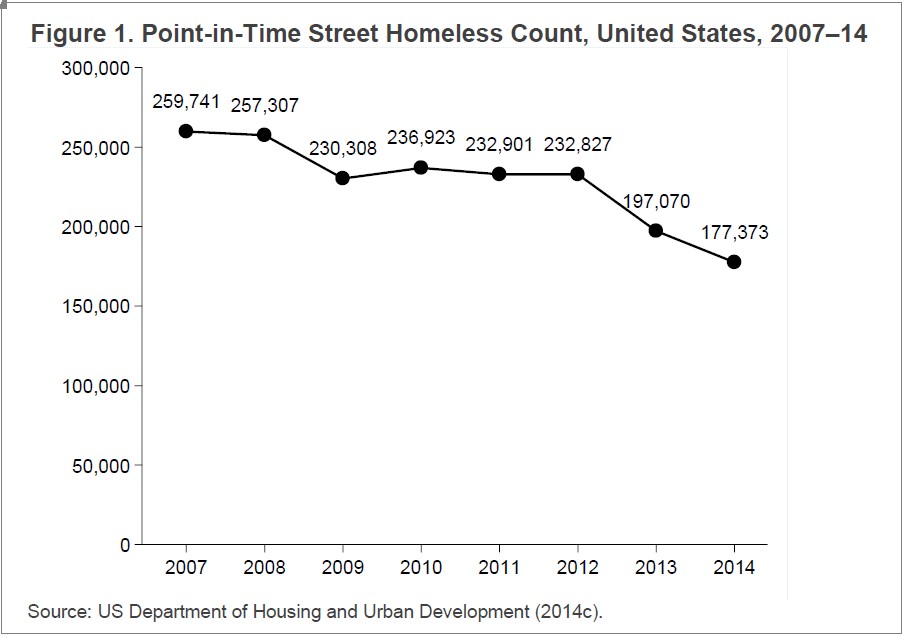U.S. local governments spend billions of dollars each year to deal with homelessness, yet the unsheltered homeless continue to occupy many American downtowns — endangering their own health as well as that of the public. Before more billions are spent on programs that don’t work for enough people, it’s time for certain cities and states to rethink their approach to this now chronic issue.
We need to start with a clear definition of homelessness and an understanding of the problem. While many housing activists focus on people doubling up in apartments because of high rents, the more pressing issue is the unfortunate souls lying on city streets — all too often with their possessions piled in shopping carts, panhandling, relieving themselves in public and leaving their used needles on the sidewalk.
Related: Tech Entrepreneur Sparks Outrage Online With Blog on Homelessness
As late as about 1970, urban homelessness was rare. City dwellers with minimal incomes typically lived in shabby Single Room Occupancy hotels (SROs), while those who seemed unable to take care of themselves were committed to state psychiatric hospitals. These systems were far from ideal: SROs were unpleasant and unsafe, and psychiatric patients were often mistreated.
During the 1970s and 1980s, cities began tearing down SROs or fixing them up for other uses, while states emptied out their mental hospitals. The first move was often an economic response to urban investment; the second was a reaction to the criticism of state psychiatric facilities. But they had the unintended consequence of fueling the rise of street living that we see today.
Today, homelessness is especially acute in affluent, liberal West Coast cities like Seattle, Portland, San Francisco and Los Angeles. According to figures from the Department of Housing and Urban Development, Los Angeles County had 28,948 unsheltered homeless individuals in 2015 — by far the largest component of the 173,268 unsheltered homeless tallied anywhere nationwide. By contrast, New York City had only 3,803. The three West Coast states of California, Oregon and Washington account for more than half the national unsheltered homeless population.
Related: New York City to Pursue Sweeping Homelessness Reforms
The good news is that the number of street homeless has been dropping since 2007. The Great Recession stopped the descent, but the downturn resumed in 2013.

But on the Pacific Coast, homelessness remains pervasive. West Coast cities are attractive to the homeless because they have relatively mild weather, little or no snow, permissive social policies and abundant services.

Source: The U.S. Department of Housing and Urban Development
As in the past, many chronically homeless individuals are alcoholics or, more recently, addicted to heroin — a growing epidemic in the United States. Federal estimates say 38 percent of homeless people are dependent on alcohol and 26 percent abuse other substances.
In many instances, this addictive behavior imposes heavy costs on city taxpayers. Some homeless addicts require frequent emergency services. The Center for Health Journalism identified one homeless man in Sonoma County, California who racked up nearly $1 million in medical costs over a period of three years.
In San Francisco, the mayor’s budget office found that, on average, 278 homeless individuals cost the public medical system $87,480 each in one year. In Los Angeles County, the top 5 percent of homeless clients each used an average of $51,227 of county services annually.
But emergency medical services are only one fiscal impact of homelessness; cities and counties are also providing temporary shelters, supportive housing, social workers and additional law enforcement officers to help the homeless. Los Angeles County estimates that it is spending an extra $965 million annually due to homelessness, with the City of Los Angeles incurring an additional $100 million.
Related: How States Are Using Medicaid Funds to Help the Homeless
In the Bay Area, San Francisco put its price tag at $241 million, while Santa Clara County, which includes San Jose and much of Silicon Valley, spent $520 million. Now the State of California is planning to step in with its own homelessness initiative.
Clearly, a compassionate society should spend money to help individuals in crisis, and it may make sense for California (and perhaps Oregon and Washington) to address homelessness at the state level. But homeless services can be provided far more cost effectively and in a way that better serves the interests of the larger community. Urban areas that are clean, healthy and safe are more likely to reap the benefits of growth from investment and new business development.
San Francisco now has the highest cost of living in the nation, with Seattle, Portland and Los Angeles not too far behind. Many working residents have been obliged to move out of these cities due to high rents and home prices. Creating more supportive housing in San Francisco and other high-cost cities not only consumes a lot of money, but it also takes high-value parcels off of the tax rolls — lowering local government revenue.
Related: VA Struggles to Help Homeless Vets
California and the nation as a whole have many communities in which housing costs are a small fraction of those in San Francisco, where medical and social service costs are more modest. It is in these communities where some of the unsheltered homeless could be housed, attended to and hopefully rehabilitated.
Coastal cities with high homeless populations can pay inland counties to take over portions of their caseload. Many inland communities have high unemployment and available real estate, so they might welcome the opportunity to provide supportive housing. Homeless individuals, with help from their advocates, can be offered incentives to enter proven addiction rehab programs that also provide job training — and a sense of community.
Under this caring and sensible approach, more homeless individuals can be housed and given a chance to reclaim their lives. The cities, then, can reclaim the streets.






